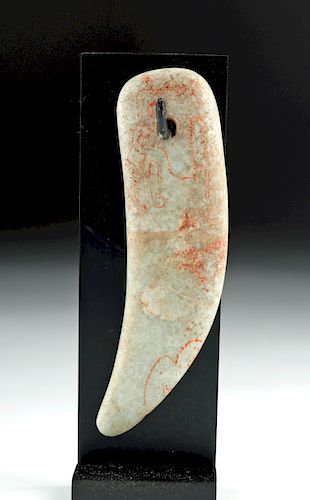Important Olmec Jade Incised Drug Spoon - Jaguar Claw
Lot 133
About Seller
Artemis Gallery
686 S Taylor Ave, Ste 106
Louisville, CO 80027
United States
Selling antiquities, ancient and ethnographic art online since 1993, Artemis Gallery specializes in Classical Antiquities (Egyptian, Greek, Roman, Near Eastern), Asian, Pre-Columbian, African / Tribal / Oceanographic art. Our extensive inventory includes pottery, stone, metal, wood, glass and textil...Read more
Estimate:
$5,000 - $7,000
Absentee vs Live bid
Two ways to bid:
- Leave a max absentee bid and the platform will bid on your behalf up to your maximum bid during the live auction.
- Bid live during the auction and your bids will be submitted real-time to the auctioneer.
Bid Increments
| Price | Bid Increment |
|---|---|
| $0 | $25 |
| $300 | $50 |
| $1,000 | $100 |
| $2,000 | $250 |
| $5,000 | $500 |
| $10,000 | $1,000 |
| $20,000 | $2,500 |
| $50,000 | $5,000 |
| $100,000 | $10,000 |
| $200,000 | $20,000 |
About Auction
By Artemis Gallery
Dec 20, 2018
Set Reminder
2018-12-20 10:00:00
2018-12-20 10:00:00
America/New_York
Bidsquare
Bidsquare : Warehouse Clear Out - Ancient & Ethnographic
https://www.bidsquare.com/auctions/artemis-gallery/warehouse-clear-out---ancient-ethnographic-3742
Time to clear out the warehouse, as these lots are going, going, gone... plus a we've added a nice selection of lots brand-new to auction! Artemis Gallery info@artemisgallery.com
Time to clear out the warehouse, as these lots are going, going, gone... plus a we've added a nice selection of lots brand-new to auction! Artemis Gallery info@artemisgallery.com
- Lot Description
**First Time At Auction**
Pre-Columbian, Mexico or Guatemala, late Olmec to early Mayan, ca. 400 BCE to 1 CE. A rare and desirable jade drug spoon in the form of a curved jaguar claw, its surface on one face incised with a serpent motif colored with bright red cinnabar and on the other face carved to have a shallow groove in the form of a real claw - made to be used for preparing hallucinogenic drugs to be consumed by shamans and elites during rituals and ceremonies. The jade is a very pale blue green, and is expertly carved. It is drilled through near the top, made to be worn when not being used. Size: 1.15" W x 3.5" H (2.9 cm x 8.9 cm); 4.5" H (11.4 cm) on included custom stand.
Research in the late 1990s and early 2000s pinpointed the source of "Olmec blue" jadeite at being in the lowland Motagua River near the modern day border of Guatemala and Honduras; stone from this source was carved and traded widely throughout early Mesoamerica. The value of jade for ancient people lay in its symbolic power: perhaps its color was associated with water and vegetation; later, the Maya would place jade beads in the mouths of the dead. Many scholars have argued that the demand for jadeite contributed to the rise of long distance trading networks and to the rise of urban centers in ancient Mesoamerica. This would have been an exceedingly valuable and rare ceremonial item.
Provenance: private Southern California, USA collection, acquired in the 1970s to mid-1980s
All items legal to buy/sell under U.S. Statute covering cultural patrimony Code 2600, CHAPTER 14, and are guaranteed to be as described or your money back.
A Certificate of Authenticity will accompany all winning bids.
We ship worldwide and handle all shipping in-house for your convenience.
#140740Excellent preservation of motifs, with much of the original cinnabar remaining. Very light surface deposits and some signs of wear commensurate with age.Condition
- Shipping Info
-
All shipping is handled in-house for your convenience. Your invoice from Artemis Gallery will include shipping calculation instructions. If in doubt, please inquire BEFORE bidding for estimated shipping costs for individual items.
-
- Buyer's Premium



 EUR
EUR CAD
CAD AUD
AUD GBP
GBP MXN
MXN HKD
HKD CNY
CNY MYR
MYR SEK
SEK SGD
SGD CHF
CHF THB
THB














